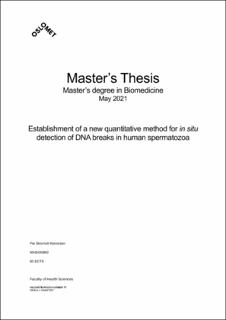| dc.description.abstract | Background: There is increasing evidence that infertile men have higher levels of DNA fragmentation compared to fertile men. It was also shown that spermatozoa with highly fragmented DNA are less motile. Several tests are available to measure DNA fragmentation in spermatozoa, but they all focus on different aspects of it and most of them lack standardization. Sperm Chromatin Structure Assay (SCSA) is a standardized method that relies on fluorescence detection by flow cytometry and involve use of a licensed software. In 2020, a new method for measuring DNA fragmentation was published: STRIDE (SensiTive Recognition of Individual DNA Ends). The method is based on fluorescence microscopy and can detect single (sSTRIDE) or double (dSTRIDE) strand breaks in individual cells. In addition to detect DNA breaks in cell lines, STRIDE also showed a potential for measuring DNA fragmentation in spermatozoa.
Aim: The main aim of this project was to establish and optimize sSTRIDE and dSTRIDE protocols for measuring DNA fragmentation in spermatozoa. Before that, we aimed to reproduce the STRIDE protocols in a somatic cell line as described in the original publication. At last, we wanted to compare results from STRIDE analyses with DNA fragmentation index values obtained earlier by SCSA in the same semen samples.
Methods and materials: The MCF-7 cell line was used in attempts to reproduce STRIDE in somatic cells. Semen samples for STRIDE establishment and optimization were provided by Fertilitetssenteret in Oslo. In addition, some samples were obtained from an ongoing method-developing project in the research group. Samples from a biobank at OsloMet were used to compare DNA fragmentation analysed by dSTRIDE and DNA fragmentation index by SCSA. Heparin and DTT was used to decondense the chromatin structure in spermatozoa. Induction of DNA damage in the different cell types was performed using different amounts of hydrogen peroxide and UVB-irradiation. Immunofluorescence procedures to detect gamma-H2AX, a marker for DNA double stranded breaks, were performed to confirm the induction of DNA breaks. STRIDE signals were collected by 2-D and 3-D microscopy and analysed using the software ImageJ.
Results: While we tried to make both dSTRIDE and sSTRIDE work in MCF-7 cells, only the dSTRIDE method was reproducible. The sSTRIDE method was then not further investigated. During the optimization of dSTRIDE in spermatozoa, coverslips were replaced with centrifuge tubes to minimize the un-specific background. A facultative chromatin decondensation step was implemented in the final dSTRIDE protocol and was shown to result in a larger number of positive signals. An increased amount of dSTRIDE foci was observed in the nucleus of spermatozoa after hydrogen peroxide exposure and UVB radiation compared to non-exposed cells. Motile spermatozoa prepared by swim-up harboured less dSTRIDE foci compared to spermatozoa from the whole ejaculate. Finally, no significant correlation was observed between the values obtained by dSTRIDE those generated by previous SCSA analyses in the same samples.
Conclusion: dSTRIDE was established in MCF-7 cells and optimized for a robust protocol in spermatozoa. Unfortunately, the DNA-fragmentation results from dSTRIDE and SCSA did not correlate. Further work is necessary to validate and standardize the method so it can be used routinely. | en_US |
